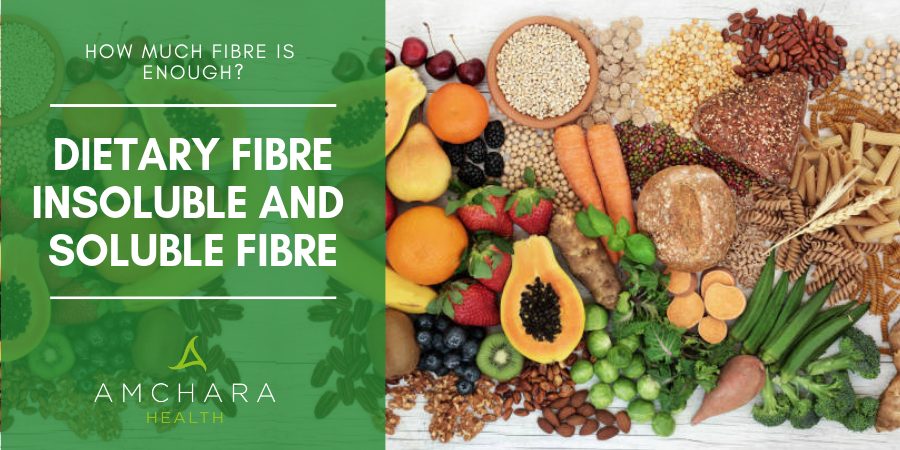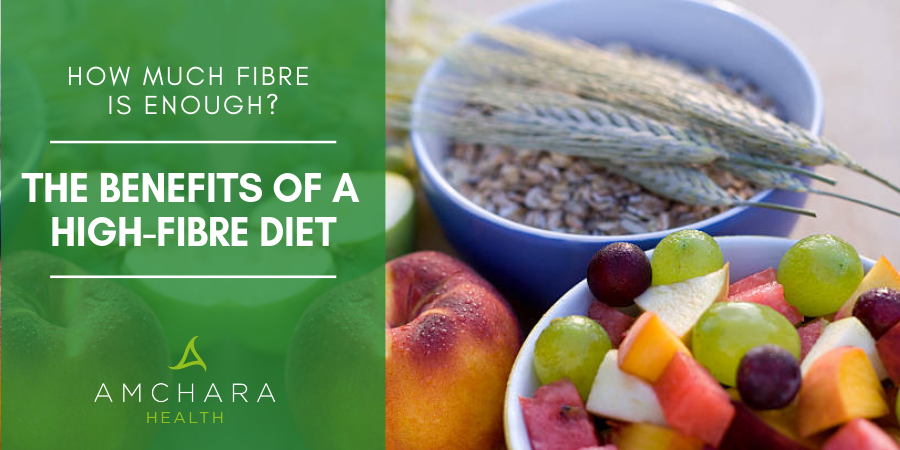Topics Covered in this article:
It’s recently been reported we aren’t eating enough fibre.
The British Nutrition Foundation tell us on average men consume 20.1g per day and women only 17.2g per day.
This is against the recommended intake of 30g per day for an adult.
But what’s the big deal about fibre? And what happens when we don’t eat enough?
Our evidence-based approach is orientated towards the Personalised Health approach which treats you as an individual and takes a tailored approach considerate of your unique physiology.
In this article, we’ll look at why fibre is important, how much we really need and how to increase our fibre intake.
Fibre is the parts of plant-based carbohydrates which can’t be digested. It’s often called ‘roughage’.
Fibre leaves the stomach and small intestine and ends up in the large intestine.
It’s commonly thought fibre is only concerned with preventing constipation, but fibre is now known to be connected to a wide range of health effects.
Ensuring you’re eating sufficient fibre has significant benefits for many aspects of our health and wellbeing.
Types of Fibre
Fibre has traditionally been classified as either soluble or insoluble, although science now understands there’s a crossover between these two categories.
Most foods contain a combination of both.
For example, wheat is mainly insoluble fibre, oats a relatively even mixture of both, and psyllium is largely soluble fibre.
- Insoluble Fibre
Insoluble fibre is what people often think of when they think of fibre.
It can’t dissolve in water and remains in the bowels unchanged, increasing the bulk and softness of the intestinal contents.
It therefore aids the movement of material through the digestive system, so it’s great at alleviating constipation.
A bulky stool is easier to pass. If you suffer from loose, watery stools, fibre can absorb water and add bulk and so help to solidify the stool.
Insoluble fibre is mainly comprised of cellulose and is found in whole grains, nuts, beans and vegetables, as well as wheat bran.
- Soluble Fibre
This type of fibre dissolves in water to form a gel-like material in the intestines.
There it provides food for the bacteria living in our gut.
Soluble fibre includes pectin found in apples and beta-glucans which are found in oats.
These have special health benefits of their own which we’ll talk about later.
Soluble fibre is found in apples, citrus fruits, oats, peas, beans, carrots, flax seeds and psyllium.
Prebiotics are a special type of soluble fibre.
Examples of prebiotics include fructo-oligosaccharides (FOS) and inulin.
They’re so-called because they are extremely beneficial to the bacteria living in our large intestine, helping them to grow and reproduce.
Prebiotics are found naturally in foods such as leeks, Jerusalem artichoke, asparagus, onions, garlic and oats.
Health Benefits of Fibre
Let’s have a look at some of the benefits of eating sufficient fibre.
- Fibre Supports Digestive Health
Apart from promoting regular bowel movements, fibre can reduce the risk of haemorrhoids.
It is also connected with less likelihood of developing diverticular disease.
This occurs when tiny pouches form in the colon wall, which then traps food particles and become inflamed.
If the intestinal contents move along too slowly, toxins destined for the outside world may end up being reabsorbed into the blood, placing double duty on the liver.
Bacteria in our large intestine break down soluble fibre and use the resulting carbohydrates as an energy source, helping them to grow and thrive and keeping our digestion happy.
In the course of this process, the bacteria produce short-chain fatty acids (SCFAs).
These provide the main source of nutrition for the cells of your colon and play a role in fighting inflammation.
Research has found eating plenty of fibre may reduce the risk of developing colorectal cancer.
This could be partly because speeding up the rate the intestinal contents move means toxic substances stay in contact with the intestinal walls for less time and can, therefore, do less damage.
- Fibre Helps Balance Hormones
When our body breaks down excess hormones such as oestrogen, they are excreted through the intestines in our bile.
If the intestinal contents travel too slowly, this oestrogen can be re-absorbed back into the body.
It’s especially likely this will happen if our digestive bacteria are out of balance because certain gut bacteria have the job of metabolising oestrogen.
An imbalance in our friendly bacteria can directly lead to excess oestrogen and hormone imbalance.
There’s also a link between dietary fibre and a substance called Sex Hormone Binding Globulin, which is produced by our liver and binds to sex hormones, so helping to maintain a correct hormone balance.
- Fibre ’s Role in Blood Sugar Levels
A review of studies (1) found eating more fibre significantly improved blood glycaemic control.
Diets high in fibre are connected with lower levels of Type 2 diabetes.
The fibre in food can slow the absorption of sugar and therefore prevent spikes in blood sugar levels.
- Fibre May Help Weight Loss
Fibre, particularly the soluble variety, may help with weight loss by regulating our appetite – in other words, filling us up.
This makes sense as high fibre foods are denser and contain fewer calories.
Research suggests SCFAs may stimulate the release of hormones which act as appetite suppressant hormones, such as peptide YY.
- Fibre and Cardiovascular Health
Studies suggest an intake of dietary fibre is inversely associated with cardiovascular disease (2).
Oats contain a type of soluble fibre called beta-glucan which has been found to lower LDL (‘bad’) cholesterol levels.
One review of studies found a good intake of high fibre foods was related to reductions in blood pressure.
- Fibre May Prevent Cancer
Low fibre intake is associated with increased risk of various cancers including colorectal cancer and gastric cancer (3).
Because of fibre’s contribution to hormone balance, it may also protect against oestrogen dependent cancers such as breast and ovarian cancer.
How to High Fibre Your Food
Let’s go back to those recommended intakes.
The advice is we should currently be eating 30g fibre per day – but since we’re all unique, a functional medicine approach will recognise there will be considerable individual differences in requirements.
On average, children between 2-5 years of age need 15g fibre per day, those between 5 and 11 need 20g, and older children aged 11- 16 need 25g per day. (4).
High fibre foods are considered to be those which contain at least 6g fibre per 100g.
So, choose plenty of these to obtain a good mix of soluble and insoluble fibre.
Although fibre content of typical foods does vary according to the season, where it’s grown, and its individual variety, we can measure the average fibre content of foods.
Chia seeds come up trumps as a great source of fibre, delivering an impressive 34.4g per 100 grams, while flaxseeds contain 27.3g per 100g.
Both are largely composed of soluble fibre.
Figs and prunes contain 18.5g and 16.1g per 100 g respectively, coconut comes in at 13.6g and oats around 10.6g per 100 grams.
Nuts such as almonds contain an impressive 12.5g per 100 grams.
Artichoke is not far behind, with 8.6g per 100 grams.
Split peas and lentils contain 8.3g and 7.9g per 100 grams each.
Avocados are surprisingly high in fibre, containing 6.7g per 100 grams, while raspberries contain 6.5g fibre per 100 grams.
Good fruit sources of fibre include pears, which contain an average of 5.5g in a medium-sized pear, apples around 4.4g in one apple, bananas around 3.1g each.
And the best news ever? Good quality dark chocolate contains a whopping 10.9 grams per 100 grams (5).
Other suggestions to fibre-up your eating include:
- Choose whole grain foods rather than processed ones which have had their fibre removed.
- Eat plenty of fruit, vegetables, beans, peas and legumes. Add beans or lentils to soups or salads.
- Snack on mixed nuts, seeds and salt- and sugar- free popcorn.
- Don’t peel fruit and vegetables, as fibre is concentrated in the peel and skin.
- Add ground flaxseeds or chia seeds to yogurt, porridge or smoothies.
- Try a chia pudding with coconut flakes and chopped almonds.
- Juices contain less fibre than smoothies, which are made from the whole fruit or vegetable.
- Consider taking a supplement of psyllium, along with plenty of water.
Easy Does It
Increasing fibre too quickly can lead to gas, bloating and cramps, so it’s best to increase it gradually.
This way, your intestinal bacteria will have time to adjust.
Spread fibre across all your meals and snacks and increase your fluid intake at the same time.
If you find your digestive system complains when you eat fibre, it’s best to consult a nutritional therapist who can advise the best types of fibre for you.
How Much is Too Much?
Although plenty of fibre is hugely beneficial, eating too much has its downsides too.
The official advice is to limit fibre intake to no more than 70g per day.
Eating more than this can lead to bloating and gas, and there’s also a risk you’ll feel too full from all the fibre to be able to eat sufficiently to meet your other nutrient needs.
If you eat lots of fibre and don’t drink sufficient fluids, you may become more constipated.
Some studies have suggested fibre can reduce the amount of calcium and other minerals which are absorbed from food, however, others have actually found absorption of minerals was increased.
More research is needed, not least because these studies used various different types of fibre.
Finally, soluble fibre like inulin and FOS can cause unpleasant symptoms in anyone suffering from SIBO.
This stands for Small Intestine Bacterial Overgrowth; it happens when the beneficial bacteria which should live in our colon have colonised the small intestine, where they’re not usually found.
If we then eat foods high in prebiotics this feeds the bacteria.
Symptoms like burping, bloating and gas soon after eating may indicate you have SIBO.
Conclusion
If you eat a variety of whole foods, getting enough fibre shouldn’t be a problem.
However, if you tend to stay away from high fibre foods because you can’t tolerate them or they cause digestive upset, this may be a sign your digestive system needs a little TLC.
A consultation with an Amchara practitioner, in conjunction with biochemical testing to determine how your digestive system is functioning, can help put things right.
This doesn’t need to be the end of the article. With your help let’s continue the conversation.
Did you find this article useful? Let us know your top tips to increase your fibre intake.
We love to hear from you!
by Cathy Robinson BScDipNutMed
READ NEXT:






